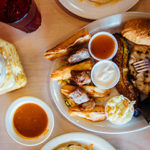The excerpt that jumped out at me from the story, called “Grub” (subtitle: “Eating bugs to save the planet”), by Dana Goodyear, had to do with a common pest that I’ll bet every trade-show organizer has had to deal with: pirate exhibitors. But I’ll wager dollars to chocolate-covered crickets that your pirate exhibitors never have peddled wares quite like these:
Insects were among the original specialty foods in the American gourmet marketplace—inspired, impractical provocations that, like runway styles in retail clothing, drove the sales of more basic goods. In the early nineteen-forties, Max Ries, a German-Jewish textile manufacturer, came to Chicago and established himself as a purveyor of imported cheese to an American public that was beginning to be fascinated by exotic food. Ries was slim and dashing; he wore handmade suits and twirled his cigars. Alongside tinned tiger and elephant meat—culled from zoos and sold at department stores—he presented “French-fried ants” from Venezuela and baby bees from Japan, conversation pieces that lent glamour to his company, Reese Finer Foods, which actually made its money selling canned water chestnuts, artichoke hearts, and baby corn. Like fashionistas, gourmets have a sense of theatre. Excluded from the first Fancy Food Show, at the Sheraton-Astor, in New York, in 1955, Ries hired a limousine to shuttle buyers to a nearby hotel, where he had set up his own show, exhibiting only Reese products. (After that, the New Yorkers relented and gave him a booth, which became a mainstay.) When Reese had overstock of its Spooky Foods gift set—chocolate-covered ants, roasted butterflies, barbecue bees—it hired Bela Lugosi to appear in his Dracula costume with the product, which promptly sold out.
That’s awesome. And, as we can see, the organizers of the Fancy Food Show employed a tried-and-true method of dealing with pirate exhibitors: bringing them into the fold!



